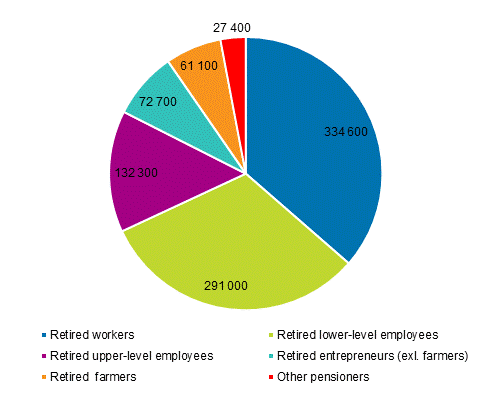Published: 8 March 2019
Retired upper-level employee households are well off
According to Statistics Finland's income distribution statistics, there were 920,000 pensioner households in Finland in 2017, which is already good one-third of all households in the country. Pensioner households have large income variations. Households of retired upper-level employees had clearly the highest income. Among employed active households only upper-level employee and entrepreneur households received more income than these pensioner households did. Households of retired former farmers and pensioners living on national pension had the lowest income of pensioner households.
Median income of pensioner households by the reference person's socio-economic group in 1995 to 2017, EUR in 2017 money

Income concept equivalent disposable monetary income per household, median. Equivalent income is the household's disposable monetary income divided by the household's consumption unit figure. The household reference person is as a rule the member of the household with the highest income. The socio-economic group of a pensioner household is determined by the economic activity of the reference person before retirement.
The median for households’ equivalent disposable monetary income was EUR 23,000 in 2017. For pensioner households, the corresponding income was EUR 19,000. The median income of retired upper-level employee households is highest with respect to all pensioner households, in 2017 it was EUR 28,000. This group included good 130,000 households and a total of 210,000 persons.
The clearly higher income of retired upper-level employee households than other pensioners is primarily explained by their good earnings-related pension. In addition to this, their income increased to some degree by the income received from the markets, the most significant of which was property income related to wealth.
Among pensioner households, retired farmer households had the lowest income, their equivalent median income being EUR 14,900 in 2017. Those pensioner households where the household reference person was other than a recipient of employment pension (other pensioner) had only slightly higher income. The median income of these households living primarily on national and guarantee pension was EUR 15,100. Both of the above-mentioned low income pensioner groups are fairly small, because the number of retired farmer households was good 60,000 and that of other pensioner households around 27,000 in 2017. These pensioner households with the lowest income included 120,000 persons
Numbers of pensioner households by the household reference person’s socio-economic group in 2017

Among pensioner households, the biggest group was formed by retired worker households, numbering 335,000. The equivalent median income of this group was EUR 17,800. The next biggest pensioner group constituted households of retired lower-level employees, being 290,000. Their median income was EUR 19,400. The number of retired entrepreneur households (excl. farmers) was 73,000 and the group's median income was EUR 18,500.
The examinations above were made with the median for equivalent disposable monetary income. In one-person households, equivalent median income is the same as the household's median income. In other households, households’ median income is derived by multiplying equivalent median income by the household’s consumption unit figure.
Source: Income Distribution Statistics 2017, Statistics Finland
Inquiries: Pekka Ruotsalainen 029 551 2610
Director in charge: Jari Tarkoma
- Tables
-
Tables in databases
Pick the data you need into tables, view the data as graphs, or download the data for your use.
- Quality descriptions
Updated 08.03.2019
Official Statistics of Finland (OSF):
Income distribution statistics [e-publication].
ISSN=1799-1331. Poverty 2017. Helsinki: Statistics Finland [referred: 19.4.2025].
Access method: http://stat.fi/til/tjt/2017/02/tjt_2017_02_2019-03-08_tie_001_en.html

